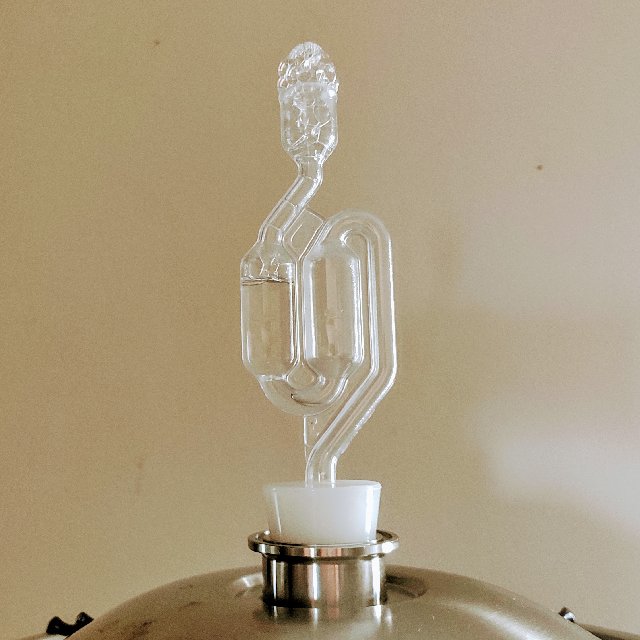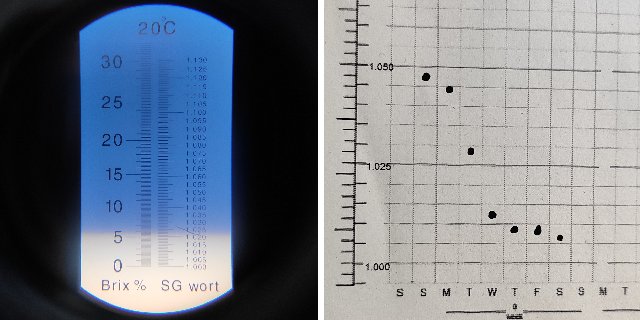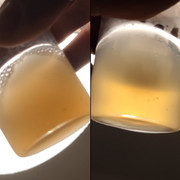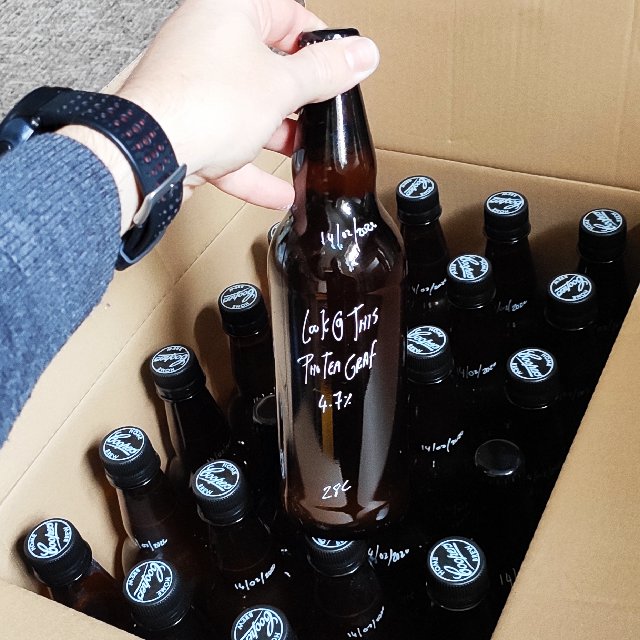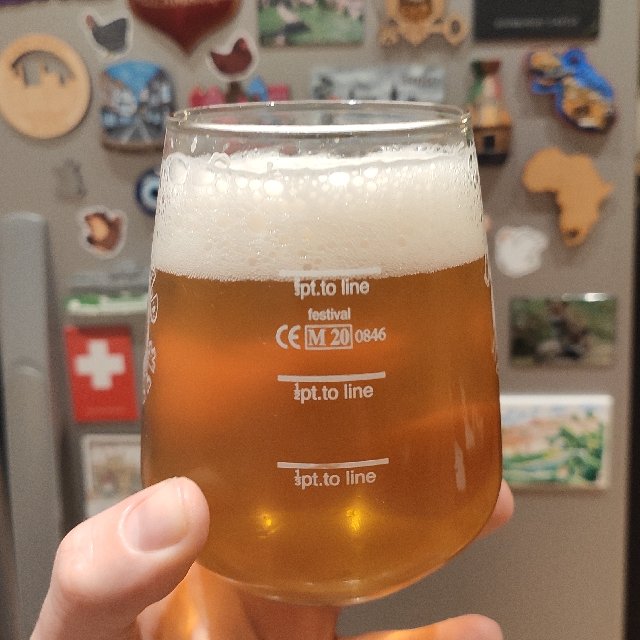Harry Wright
Active Member
I have been planning on brewing something weird for a while, however I generally stick to the classic styles and like to make nice clean beers. This weekend that trend ended. Have a look at this set of ingredients, a combination of things that I am not sure will work together, but hay, what better way to learn some new techniques.
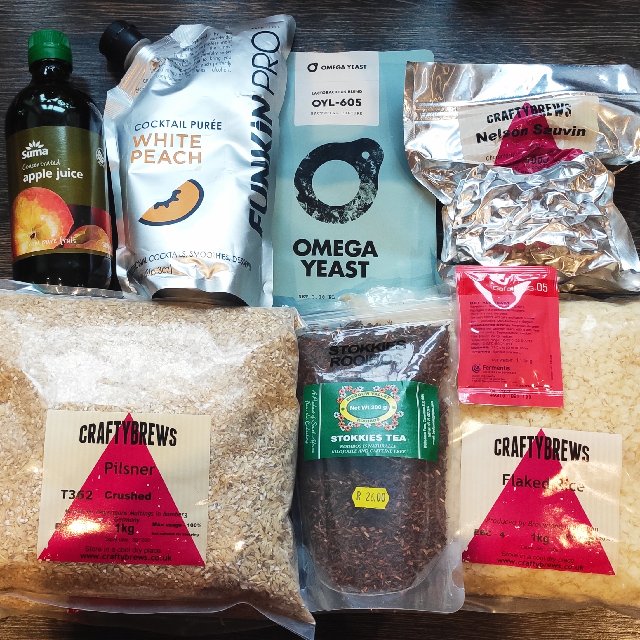
So bear with me, I am excited about this beer, so this might be a long type up. I hope that there will be enough pictures to keep you interested.
I wanted to try Nelson Sauvin hops for the first time and decided to build my beer around these hops. Something else I really wanted to try was to do a kettle sour. So this is where I started. The plan, make a kettle soured beer that would have the characteristics of a dry white wine.
This started with the malt bill, for me it needed to be simple, with clean flavours to set a nice malty base, with all the flavours coming later. So I went with a mostly pilsner malt base and a little bit of flaked rice, to keep it nice and dry. The kettle souring would come from a mixed lactobacillus culture from Omega Labs OYL605. Coming from South Africa I love rooibos tea, however I have had a few beers with rooibos and they are often way over done and taste like ice tea, I just wanted a little bit of the earthy and woody flavours so decided to use as little as necessary. Finally, I wanted to add some serious fruity flavours and figured the only way to do this was with some actual fruit juice. So decided to use apple concentrate and some peach puree. I did not want the yeast to add much more flavour so decided to stick with some clean fermenting Fermentis Safale-US05.
With this base of fermenting sugars, I guess the beer is a kettle soured graf (a Stephen King invention I believe) with tea.
So let’s get to it. This brew started on Friday morning, following the directions for the Omega labs OYL605. I needed to make a 1 l starter of 1.040 wort, so boiled some water and added and dissolved the required DME. I ended up making a 1.6 l starter, as I wanted to save some of the bacterial culture (£10 a packet). I left this for 24 hours next to the radiator with no stirring.
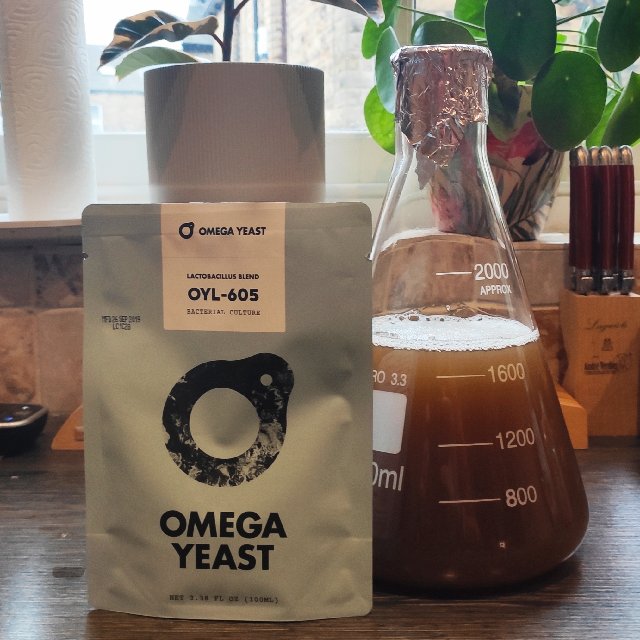
Brew morning (Saturday), started with a nice cup of coffee to get me on my A game for a day of brew firsts. I collected my mash water (11 l) and my sparge water (16.5 l), broke a campden tablet in two and started heating my strike water to 71 °C. My grain was pre milled so once my water was at temperature I slowly added and stirred it in (2 kg pilsner malt and 0.6 kg flaked rice). Nothing like the smell of grain steeping on a Saturday morning.
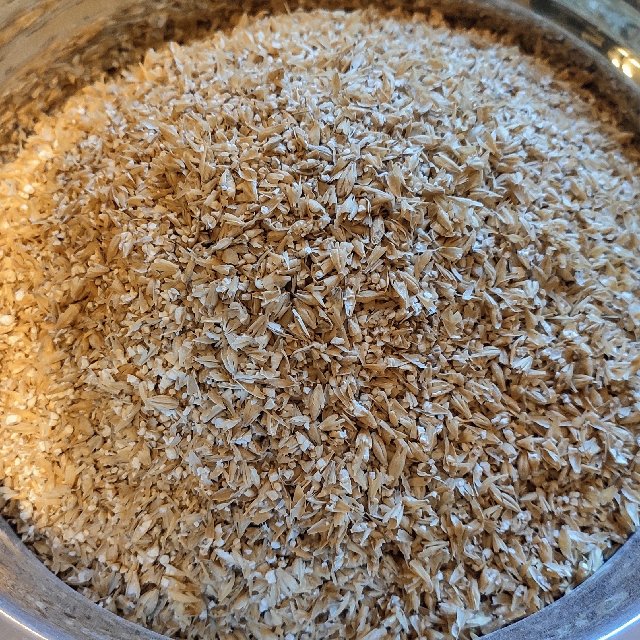
I did a 60 min infusion mash at 67 °C with recirculation, and then mashed out at 76 °C for 10 min. I heated my sparge water to 76 °C and sparged until I had collected my pre boil volume of 25 l. The wort was running lovely and clear by the end of the mash, this has been by far the lightest colour wort I’ve made but loved the straw colour.
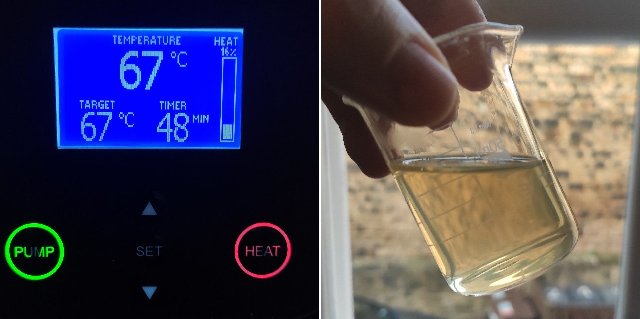
A short 15 min boil is what followed next. The boil was to reduce any bacteria or wild yeasts, so that it will be a more controlled souring process. I cooled the wort to 30 °C so that I could pitch the lactobacillus starter. I poured 600 ml of the starter into a sanitised pickle jar and saved that in the fridge (hopefully this lasts until my next sour, if not no harm done). Pitched the remaining 1 l of lacto starter into the wort, purged the headspace in the kettle with CO2 and covered with sanitised plastic film.
I was interested in whether or not the lacto would change the gravity so took a reading and it was 1.033. The pH was between 5 and 5.5 (pH strips). I also gave it a smell and taste, nice grainy smell and the characteristic malty goodness of pilsner malt, it definitely tasted a little bit thin, however this wasn’t unexpected with some of the sugars still to come. At this point, the wort left to sour for 24 hours at 30 °C. I cleaned the grain basket and was done for the day and it was only midday, win!
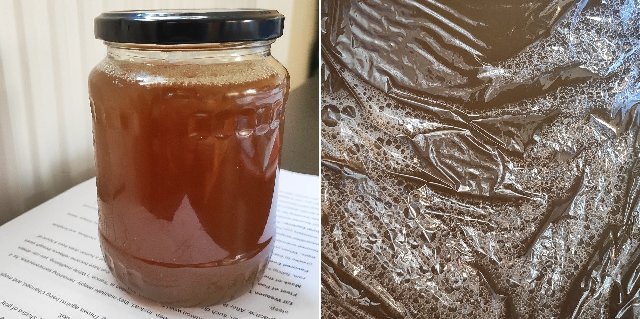
I woke up this morning and was eager to see what, if anything had changed.
As soon as I opened the lid of the kettle, I knew something had happened. BANG, massively sour aroma and a very strange taste, at least like nothing I’ve tasted before. The combination of the still quite sweet malt and the sourness from the bacteria was definitely something new for my palette. I checked the gravity again and it hadn’t changed, the pH on the other hand had dropped to between 3 – 3.5. The look had also changed, from a clear wort it had gone really turbid. I was happy with the amount of sourness and started to heat up to wort to a boil.
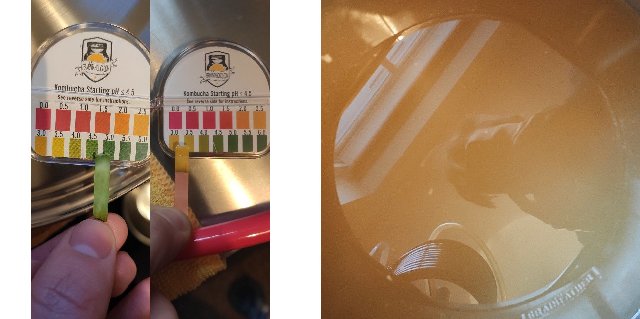
Whilst the kettle heated up to boiling, I weighed out the boil additions. I normally use pellet hops, however couldn’t find Nelson Sauvin (which I really wanted to try) in pellet hops so bought leaf hops, another first for me. With this being a sour and dry beer I didn’t want a lot of IBUS so only had a 10 min and 5 min addition of hops, 25 g each for a calculated total of 22 IBUS. A teaspoon of irish moss, added with 15 left of the boil and I also weighed out 56 g of rooibos tea, which added at flameout and steeped for 5 min. 15 min whirlpool and I was ready to cool and transfer the wort to a sanitised fermenter.
The boil was 75 min, longer than normal, from fear of the pilsner causing any DMS formation, which I imagine, would have nowhere to hide in this beer.
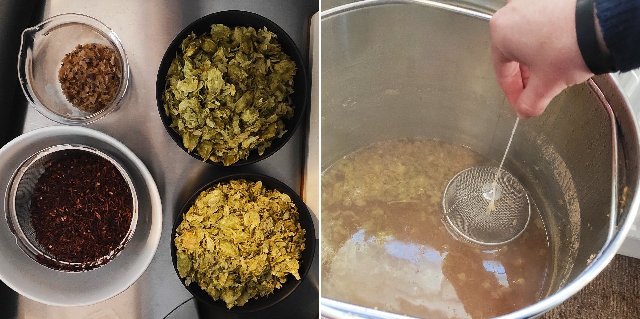
A quick taste test and I’m super surprised, the earthy flavours and aroma from the rooibos tea are there, but not overwhelming, the hops are a big flavour bang, and there is little bitterness to speak of, the malty sweetness is still there and the sour tang to finish, could this beer/ graf actually work ?
I also took a OG reading at the point, 1.040 which was the OG predicted by Beersmith, however with the fruit concentrates still to be added, I figured I had overshot possibly due to small grain bill and large amount of sparge water, resulting in higher efficiencies.
I rehydrated my US05 in 200 ml of boiled and cooled water during the transfer. I added the fruit concentrates to the fermenter.
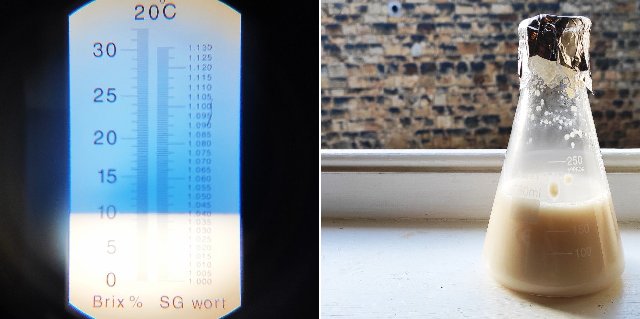
With the transfer complete and cooled to pitching temperature of 18 °C I gave the wort a good aeration with my new aeration paddle and drill and pitched the now frothy yeast. Took another sample and the final OG is 1.047. The colour is definitely a bit more yellow, with perhaps a tiny amount of red hue from the rooibos. The transferred wort isn’t clear, I assume there is some cold break in suspension after cooling.
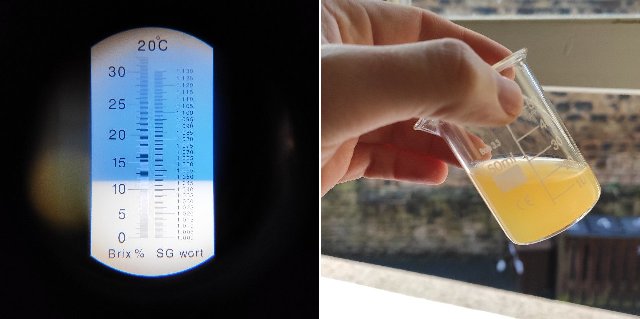
A final smell and taste test. Oh no, have I gone too far, were the fruit additions necessary, too late to remove them. The wort tastes a lot more muddled now, the tea flavours are still there, however there is now a strong apple flavour and a lot of fruit sweetness, there is little to no peach with the apple the dominating flavour. It ends nice and tart and could all work, hopefully a lot of the apple flavours will be blown off during fermentation.
Only time will tell now, I’ll keep you all up to date with how this goes and what I think are the successes and failures of this brew. Thanks for reading, and hope you’ve enjoyed my weirdest brew weekend to date. I feel no beer is complete without a name and no brewer complete without a pun game, so considering this was a fake (kettle) soured, graf with tea may I introduce you to…..
LOOK AT THIS PHO-TEA-GRAF


So bear with me, I am excited about this beer, so this might be a long type up. I hope that there will be enough pictures to keep you interested.
I wanted to try Nelson Sauvin hops for the first time and decided to build my beer around these hops. Something else I really wanted to try was to do a kettle sour. So this is where I started. The plan, make a kettle soured beer that would have the characteristics of a dry white wine.
This started with the malt bill, for me it needed to be simple, with clean flavours to set a nice malty base, with all the flavours coming later. So I went with a mostly pilsner malt base and a little bit of flaked rice, to keep it nice and dry. The kettle souring would come from a mixed lactobacillus culture from Omega Labs OYL605. Coming from South Africa I love rooibos tea, however I have had a few beers with rooibos and they are often way over done and taste like ice tea, I just wanted a little bit of the earthy and woody flavours so decided to use as little as necessary. Finally, I wanted to add some serious fruity flavours and figured the only way to do this was with some actual fruit juice. So decided to use apple concentrate and some peach puree. I did not want the yeast to add much more flavour so decided to stick with some clean fermenting Fermentis Safale-US05.
With this base of fermenting sugars, I guess the beer is a kettle soured graf (a Stephen King invention I believe) with tea.
So let’s get to it. This brew started on Friday morning, following the directions for the Omega labs OYL605. I needed to make a 1 l starter of 1.040 wort, so boiled some water and added and dissolved the required DME. I ended up making a 1.6 l starter, as I wanted to save some of the bacterial culture (£10 a packet). I left this for 24 hours next to the radiator with no stirring.

Brew morning (Saturday), started with a nice cup of coffee to get me on my A game for a day of brew firsts. I collected my mash water (11 l) and my sparge water (16.5 l), broke a campden tablet in two and started heating my strike water to 71 °C. My grain was pre milled so once my water was at temperature I slowly added and stirred it in (2 kg pilsner malt and 0.6 kg flaked rice). Nothing like the smell of grain steeping on a Saturday morning.

I did a 60 min infusion mash at 67 °C with recirculation, and then mashed out at 76 °C for 10 min. I heated my sparge water to 76 °C and sparged until I had collected my pre boil volume of 25 l. The wort was running lovely and clear by the end of the mash, this has been by far the lightest colour wort I’ve made but loved the straw colour.

A short 15 min boil is what followed next. The boil was to reduce any bacteria or wild yeasts, so that it will be a more controlled souring process. I cooled the wort to 30 °C so that I could pitch the lactobacillus starter. I poured 600 ml of the starter into a sanitised pickle jar and saved that in the fridge (hopefully this lasts until my next sour, if not no harm done). Pitched the remaining 1 l of lacto starter into the wort, purged the headspace in the kettle with CO2 and covered with sanitised plastic film.
I was interested in whether or not the lacto would change the gravity so took a reading and it was 1.033. The pH was between 5 and 5.5 (pH strips). I also gave it a smell and taste, nice grainy smell and the characteristic malty goodness of pilsner malt, it definitely tasted a little bit thin, however this wasn’t unexpected with some of the sugars still to come. At this point, the wort left to sour for 24 hours at 30 °C. I cleaned the grain basket and was done for the day and it was only midday, win!

I woke up this morning and was eager to see what, if anything had changed.
As soon as I opened the lid of the kettle, I knew something had happened. BANG, massively sour aroma and a very strange taste, at least like nothing I’ve tasted before. The combination of the still quite sweet malt and the sourness from the bacteria was definitely something new for my palette. I checked the gravity again and it hadn’t changed, the pH on the other hand had dropped to between 3 – 3.5. The look had also changed, from a clear wort it had gone really turbid. I was happy with the amount of sourness and started to heat up to wort to a boil.

Whilst the kettle heated up to boiling, I weighed out the boil additions. I normally use pellet hops, however couldn’t find Nelson Sauvin (which I really wanted to try) in pellet hops so bought leaf hops, another first for me. With this being a sour and dry beer I didn’t want a lot of IBUS so only had a 10 min and 5 min addition of hops, 25 g each for a calculated total of 22 IBUS. A teaspoon of irish moss, added with 15 left of the boil and I also weighed out 56 g of rooibos tea, which added at flameout and steeped for 5 min. 15 min whirlpool and I was ready to cool and transfer the wort to a sanitised fermenter.
The boil was 75 min, longer than normal, from fear of the pilsner causing any DMS formation, which I imagine, would have nowhere to hide in this beer.

A quick taste test and I’m super surprised, the earthy flavours and aroma from the rooibos tea are there, but not overwhelming, the hops are a big flavour bang, and there is little bitterness to speak of, the malty sweetness is still there and the sour tang to finish, could this beer/ graf actually work ?
I also took a OG reading at the point, 1.040 which was the OG predicted by Beersmith, however with the fruit concentrates still to be added, I figured I had overshot possibly due to small grain bill and large amount of sparge water, resulting in higher efficiencies.
I rehydrated my US05 in 200 ml of boiled and cooled water during the transfer. I added the fruit concentrates to the fermenter.

With the transfer complete and cooled to pitching temperature of 18 °C I gave the wort a good aeration with my new aeration paddle and drill and pitched the now frothy yeast. Took another sample and the final OG is 1.047. The colour is definitely a bit more yellow, with perhaps a tiny amount of red hue from the rooibos. The transferred wort isn’t clear, I assume there is some cold break in suspension after cooling.

A final smell and taste test. Oh no, have I gone too far, were the fruit additions necessary, too late to remove them. The wort tastes a lot more muddled now, the tea flavours are still there, however there is now a strong apple flavour and a lot of fruit sweetness, there is little to no peach with the apple the dominating flavour. It ends nice and tart and could all work, hopefully a lot of the apple flavours will be blown off during fermentation.
Only time will tell now, I’ll keep you all up to date with how this goes and what I think are the successes and failures of this brew. Thanks for reading, and hope you’ve enjoyed my weirdest brew weekend to date. I feel no beer is complete without a name and no brewer complete without a pun game, so considering this was a fake (kettle) soured, graf with tea may I introduce you to…..
LOOK AT THIS PHO-TEA-GRAF

Last edited:






























![BREWING THERMOMETER STICKERS ACCURATELY MONITOR FERMENTING BEER & WINE LIQUID TEMPERATURES 5PCS HOME BREW SPIRITS WINE LCD ADHESIVE [US]](https://m.media-amazon.com/images/I/311DDjo2X3L._SL500_.jpg)











